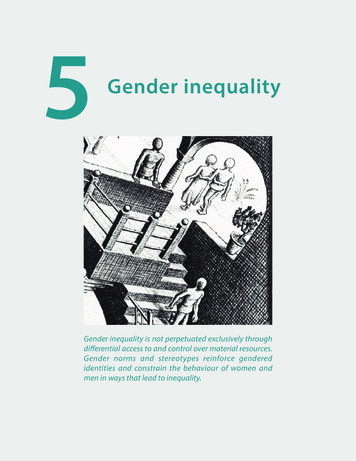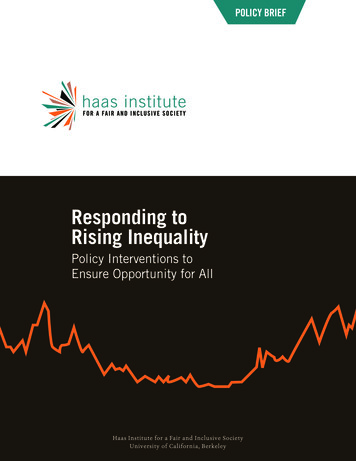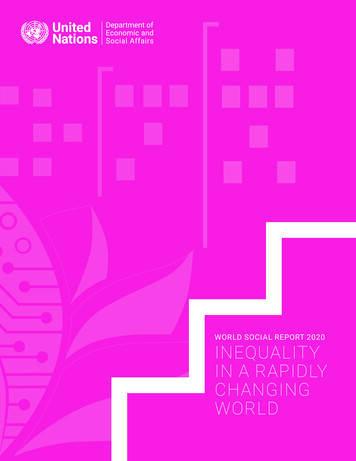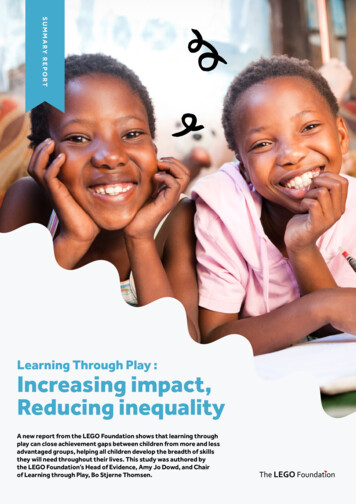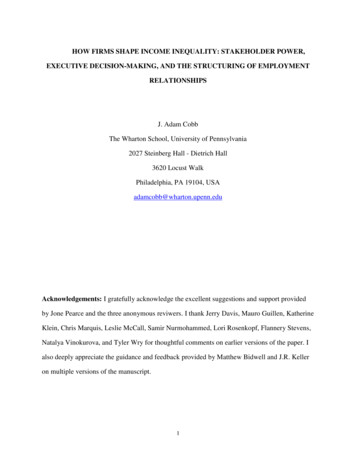
Transcription
THE RISE OF INEQUALITY: HOW SOCIAL MOVEMENTS SHAPEDISCURSIVE FIELDS*Sarah Gaby and Neal Caren†Social movement scholars have considered several political and cultural consequences ofsocial movements, but have paid limited attention to whether and how social movements shapediscourse. We develop a theory of discursive eruption, referring to the ability of radicalmovements to initially ignite media coverage but not control the content once other actors—particularly those that can take advantage of journalistic norms—enter the discourse. We holdthat one long-term outcome of radical social movements is the ability to alter discursive fieldsthrough mechanisms such as increasing the salience and content of movement-based issues.We examine the way movements shape discourse by focusing on newspaper articles aboutinequality before, during, and after the Occupy Wall Street (OWS) movement. We analyzechanges in the salience and content of coverage as well as shifts in actor standing andinfluence. Using 7,024 articles from eight newspapers, we find that the OWS movementincreased media attention to inequality, shifting the focus of the discourse toward movementbased issue areas (e.g., the middle class and minimum wage). Further, we find that comparedto the pre-OWS period, the influence of social movement organizations and think tanks rose indiscourse on inequality. In addition, the discourse on inequality became more highlypoliticized as a result of the Occupy movement. These findings highlight the importance ofsocial movements in shaping discourse and indicate that social movement scholars shouldfurther consider discursive changes as a consequence of social movements.After September 2011, “We are the 99%”—a reference to the vast inequality between thewealthy and everyone else in the United States—became a household slogan seen everywherefrom sidewalk graffiti to Facebook memes. The spread of the slogan points to the influence ofits creator, the Occupy Wall Street (OWS) movement. Although OWS successfully mobilizedaround the country in Fall 2011, the movement fizzled out, declining drastically by Spring 2012.Thus, the question remains: Did Occupy have any long-term discursive impact, and, if so, what?More generally, are ephemeral radical movements likely to be influential over the long term?The influence of social movements and organizations that employ radical ideologies andtactics remains contested in previous work. The influences of radical movement organizationsare often minimized due to their insufficient resources and inability to integrate into existingpolitical systems (Fitzgerald and Rodgers 2000). Although fleeting radical movements may notbecome integrated into the formal political process, they can still influence public opinion andpolitical actions through discursive agenda setting (Polletta 2012). In this article, we examine theimpact of a radical social movement organization on shaping public discourse. We expect thatthese types of movements are likely to be able to raise the salience of particular issues, but havemuch more modest abilities to shape media frames and their own standings (Gitlin 1980).Although the Occupy movement declined by the end of 2011 and has since lost cohesion,we find that the one major enduring outcome of the movement is increased and altered attentionto income inequality. Further, we find that while the movement was able to increase attention to* A preliminary version of this paper was presented 2014 American Sociologcial Association Annual Meeting. Wethank Edwin Amenta, Andy Andrews, Charlie Kurzman, David Meyer, Charles Seguin, members of the UNC Cultureand Politics workshop, and the anonymous reviewers.† Sarah Gaby is a Doctoral Candidate in the Department of Sociology at the University of North Carolina, ChapelHill. Neal Caren is an Associate Professor of Sociology at the University of North Carolina, Chapel Hill. Please directcorrespondence to Sarah Gaby at sgaby@unc.edu. 2016 Mobilization: An International Quarterly 21(4): 413-429DOI 10.17813/1086-671X-21-4-413
Mobilization414the issue, the radical, decentralized nature of the movement limited its ability to achieve lastingmedia standing (Gitlin 1980). OWS helped shape the discursive agenda, but other politicalactors, particularly think tanks, were better positioned to take advantage of the new opportunities. Radical social movements can achieve long-term influence, but by quickly fading theyare unable to take advantage of the opportunities they create. We call this phenomenon discursive eruption, referring to the ability of radical movements to initially ignite media coverage(Seguin 2016), but not control the content once other actors, particularly those that can takeadvantage of journalistic norms enter the discourse (Gitlin 1980).To understand the discursive consequences of social movements, we constructed an originaldatabase of 7,024 newspaper articles on inequality between 2002 and 2013. Since incomeinequality was the most pressing issue in the OWS movement, this set of articles provides anopportunity to trace discursive changes brought on by OWS, and those that persisted once themovement formally declined. We analyze both the volume of coverage on inequality and thecontent of that coverage, including actor standing. Our findings indicate that OWS generallyincreased attention to income inequality, which endured after the movement declined. Further,increased attention to inequality also changed the standing of who spoke on specific inequalitytopics. While the movement was prevalent in the discourse during its height, OWS was unableto remain in the conversation after its decline. Instead, political actors became increasinglyengaged in the discourse following the politicization of inequality by the movement.MOVEMENT-MEDIA INTERACTIONSSocial movements aim to shape policies and public opinion, often utilizing the media as amechanism of influence. Movements typically seek media coverage, and specifically favorablecoverage of their issues (Andrews and Caren 2010; Gamson and Wolfsfeld 1993). These groupsneed a means through which to communicate their messages and ideas to the public (Smelser1963) and to elites (Andrews and Caren 2010), and the media often serves that role. Mediaattention may serve as an instrument for achieving other goals, but may in itself be a goal ofsocial movements (Amenta, Caren, Olasky, and Stobaugh 2009). To gain media attention, socialmovements often take radical actions (Gitlin 1980). In doing so, however, they frequently gainunfavorable attention. Whether and how radical movements produce lasting influences throughmedia coverage remains contested in past work.Movements seek media attention, in part, to influence the public agenda and public opinion(McCombs and Shaw 1972; Rohlinger 2015). Media coverage can lead to increased publicattention, which can set or change political agendas (Baumgartner and Jones 1993; Smith,McCarthy, McPhail, and Augustyn 2001). People primarily gain their understanding of issuesand events secondhand through journalistic interpretations, and therefore influencing publicopinion often requires gaining a particular type of media coverage. Identifying an issue as asocial problem in the public agenda requires outcompeting many other potential issues to gainmedia and thereby public attention (Hilgartner and Bosk 1988). If successful, movements havethe capacity to shape media discourse, public understanding, and public policy. For instance,despite several previous actors attempting to shape the discourse on the death penalty, adherentsof the “innocence movement” were able to shift this discourse to focus on the potential innocence of death row inmates (Baumgartner, De Boef, and Boydstun 2008). By doing so, theyheightened attention to the issue of the death penalty, increased the cases of exoneration, andchanged public opinion and policy on the death penalty (Baumgartner et al. 2008).For movements, media coverage is a scarce and valuable commodity (Andrews andCaren 2010). As a result, movements are often pushed to use dramatic and unpredictableactions, which are successful strategies for gaining media attention (Gamson 1990). Movements that are large and disruptive, highly organized, and engaged in current policy issues aremore likely to receive media coverage (Amenta et al. 2009). By taking disruptive actions,radical movements and organizations can successfully shape media discourse, influencing
How Social Movements Shape Discursive Fields415public opinion and public policy. For instance, movement organizations that focused on issuesat the fringes of public discourse gained control of and shaped discursive fields throughdramatic displays (Bail 2012).Radical flanks, or the radical actors within a social movement, can be leveraged strategicallyby the movement, and even integrated into its mainstream (Downey and Rohlinger 2008).Although at times radical activities may discredit more moderate approaches and appearthreatening to the broader movement, these radical movement actors may also produce positiveimpacts on the movement. A positive radical flank effect takes place when radicals serve as afoil for moderates, or create opportunities that moderates can take advantage of to make gains(Haines 1984). In these instances, radical flanks help to strengthen the broader social movement.While disruptive or radical tactics can increase media coverage (Wilkes, Corrigall-Brown,and Myers 2010; Wouters 2013), past work shows contradictory evidence about the type ofattention radical actions garner. The media are looking for clear presentation of messages andreasonable solutions, which often conflict with radical approaches (Sobieraj 2010). Further,social movements that align with mainstream values are more likely to become part of dominantmedia frames (Gitlin 1980). Movements that utilize nondisruptive tactics are found to receivemore favorable media coverage (Amenta, Gardner, Tierney, Yerena, and Elliott 2012). Althoughnegative coverage may be one outcome for radical movements, this type of coverage is notnecessarily detrimental. Negative coverage of movement actors coincides with more extensivemovement coverage (Taylor and Gunby 2016), and, while radical tactics may be stigmatized,the radical reputation of organizations may actually lead to positive coverage (Evans 2016).Although there is no consensus on whether radical movements have any meaningful impacts, a few case studies have shown discursive eruption, or how radical groups can spark mediaattention, which takes on a life of its own outside of the movement’s control (Gitlin 1980;Rhodes 2007; Seguin 2016). In several cases, this effect was found to be negative for themovement (Gitlin 1980; Rhodes 2007). For instance, in the case of the New Left, gaining mediaattention led to negative judgment of the movement and served as a justification for state-basedrepression (Gitlin 1980). While in this case the movement was able to ignite initial coverage, theoutcome of that coverage was harmful to the movement itself.Lasting Discursive InfluenceEven in cases where movements themselves are harmed by the coverage, radical movements may have long-term influences on discourse. Radical movements can put issues on thepublic and political agenda that outlive the movement and have a broader influence. For instance, movements may have a longer-term effect on language (Goodwin and Jasper 1999), andshape public discourse through coverage of their frames (Ferree 2003; Ferree, Gamson, Gerhardsand Rucht 2002) and by constructing meaning (Gamson 1992; Gamson and Modigliani 1989).These outcomes can extend influence beyond the direct involvement of the movement.By gaining coverage of an issue, movements can also bring powerful actors and politicalelites into the conversation. Movement actors may temporarily gain standing by receivingcoverage, but media reporters primarily seek sources that are influential and commandauthority, which often do not coincide with movement representatives (Andrews and Caren2010; Corbett 1998). Instead, political elites are frequently given automatic standing and havethe capacity to control a significant amount of media coverage (Gitlin 1980). Typically, mediapractices dictate unbiased coverage that includes both liberal and conservative viewpoints(Sobieraj 2010). As a result, nonmovement actors may enter the conversation on a particularissue as it enters the discourse, and, by gaining media coverage, may bring in additional actorsthat help to centralize the discourse further into the mainstream (Rhodes 2007). Radicalmovement actors, however, are unlikely to control discourse around an issue once it enters themedia. Still, for movements, and particularly radical movements, placing an issue on thediscursive agenda can be an important source of influence, which can extend beyond themovement to influence the public and political agenda.
Mobilization416THE INFLUENCE OF OCCUPY WALL STREETAgainst a background of revolution and upheaval in other parts of the world, the Canadian notfor-profit magazine Adbusters printed an advertisement asking the public, “Are you ready for aTahrir moment? On Sept 17, flood into lower Manhattan, set up tents, kitchens, peacefulbarricades and occupy Wall Street.” The ad ran on July 13, 2011, which is often credited as theformal start of this radical social movement. This call was echoed by a diverse group ofpreexisting entities, ranging from the hacktivist collective Anonymous to the community laborcoalition New Yorkers Against Budget Cuts. With the debt-ceiling deadline of midnight August2, the group chose that day to incorporate a “General Assembly” as others simultaneously held astrategy session for Occupy Wall Street. The two groups joined in a demonstration at the Charging Bull sculpture, which stands in Bowling Green park in Lower Manhattan, at 4:30 p.m.Afterward, these two groups joined together to plan for the September 17 event.On September 17, around 1,000 people attended the protest at Zuccotti Park. Smaller newsmedia quickly began to cover the protest events. By September 21, The Guardian and the NewYork Times began reporting on the movement. A few weeks into the movement, CNN created arecurring highlight called “Occupy News” (Gitlin 2012). As the movement spread across thecountry (Caren and Gaby 2011), so did media coverage, “ to the front pages of newspapersand the tops of television newscasts” (Stelter 2011). Coverage of the movement becamecomparable to that of the Tea Party Movement during its peak period (Sartor 2011).As a movement with radical ideology and disruptive tactics, OWS gained media coverageas anticipated. We would also expect, consistent with the presence of discursive eruption, thatthe volume of coverage of its primary issue, inequality, also increased.H1: OWS increased the salience of inequality in the media.There is some preliminary evidence of increasing coverage on inequality. In a study of theOWS’s impact, Milkman and colleagues (2013) analyzed its media coverage and found thatduring the Zuccotti Park occupation, media coverage of inequality was significantly higher.Discursive eruption likely occurred during this time period, with the movement able to sparkmedia coverage of inequality. After the evictions, coverage fell but was more compared to theperiod before the movement (Milkman, Luce and Lewis 2012). Several pundits noted theincreased attention to issues of inequality driven by the movement as well (Linkins 2011). OWSbrought up the issue of inequality and “it’s not going away” (Milkman et al. 2012: 37).Although the movement likely raised the media salience of inequality, coverage of particular ideas remains dictated by media practices and journalistic norms (Gamson and Wolfsfeld1993). As a result, there is no expectation that OWS’s discursive eruption operated differentlyfrom past movements in its ability to influence the content of discussion on their primary issue.H2: OWS did not influence the content of the discourse around inequality.In addition to limiting the ability to gain specific forms of coverage, media practices alsoinfluence who gains coverage, favoring elected and appointed officials (Gamson and Wolfsfeld1993). Movement actors must compete for discursive influence with various other actors,including groups working on the same issue or those with competing viewpoints (Hilgartner andBosk 1988). As a result, movement actors rarely enter news coverage. When media officials letoutsiders into their reporting, they often look for authenticity through emotional and spontaneous responses (Gamson and Wolfsfeld 1993; Sobieraj 2010). Often, however, activistsperceive these same elements as factors that will limit coverage, so they reduce spontaneity andemotion in their interactions with the media (Sobieraj 2010).H3: OWS was not able to increase the standing of social movement organizations in themedia.For the Occupy Wall Street movement, although they may have achieved discursive eruption inthe height of the movement, skepticism about corporate media outlets and desire to control media
How Social Movements Shape Discursive Fields417messaging led activists to create their own independent media including live streaming bothplanning and actions (Byrne 2012). Due to their weariness of mass media, some occupiersactively avoided engaging the media, even posting signs in their camps that read, “Don’t talk tothe media ” (Carpenter 2012). The aversion to engaging with traditional media likely keptactivists from authentically engaging with reporters.Although difficult, social movements have the capacity under certain conditions to gainstanding in the media, often through dramatic actions (Bail 2012). Therefore, it remains possiblethat the tactics employed by OWS could influence standing.H4: OWS increased the standing of social movement organizations in the media.Although the movement sought to avoid media coverage, reporters continued to visitoccupations, often able to locate willing and, at least at times, authentic occupiers to interview.The public nature of the occupations and the various groups of individuals involved oftenled to spontaneous and emotional activist interactions with the media. For instance, in an earlyarticle on the movement in the New York Times, the first sentence introduced Zuni Tikka, whothey referred to as “ a default ambassador in a half-naked woman ” (Gitlin 2012). Theserepresentatives may have been able to increase the movement standing.Unlike movement actors, the media give standing to political actors freely (Gamson andWolfsfeld 1993). The media actively pursue political insiders, and, because journalists oftenseek balanced reporting, typically capture individuals on both sides of the political aisle(Sobieraj 2010). These norms, in part, limit the ability of movement actors to remain involvedafter initial discursive eruption.H5: Post-OWS, left and right political actors are equally prominent in inequality discourse.The OWS movement also coincided with the 2012 presidential campaign, in which discourse on inequality played an important role. For instance, on the Today Show, Mitt Romneyin his Republican presidential candidacy responded to increased attention on incomeinequality as a form of “envy” and “class warfare” (Luhby 2012). This provides limited evidence that raising the salience of the issue resulted in political actors on both sides of the aislejoining in the conversation. Media coverage of the political campaign likely further integratedpolitical actors into the discourse on inequality.Despite norms of coverage that lead the media to seek unbiased reporting, some issuestend to land more on the agenda of the political right or left. For instance, issue ownershipexists in coverage around topics like civil liberties, civil rights, and social welfare, such thatthose issues lean towards more Democratic Party coverage (Petrocik, Benoit, and Hansen2003). Issues around inequality are also likely to be “owned” by the political left, andtherefore might lead to more coverage for the left.H6: Post-OWS, left political actors are more prominent in inequality discourse.Hypothesis 1, 3, and 5 are consistent with our theory of discursive eruption. We wouldexpect that a radical, disruptive movement would be able to gain issue coverage, but not increase their standing or shift the partisan balance.DATA AND METHODSIn order to analyze the impact of OWS on discourse around inequality, we used LexisNexis tosearch for articles that contained any mention of the term, “inequality” from January 1, 2002 toDecember 31, 2013 from eight news sources: Washington Post, USA Today, New York Times,Philadelphia Inquirer, Denver Post, Atlantic Journal Constitution, Chicago Tribune, AssociatedPress, and the McClatchy and Knight Ridder News Services.1 We selected these six newspapersand two wire services because they represented both the largest papers available through Lexis-
Mobilization418Nexis (in terms of distribution) and also included geographic variety and political diversity ineditorial viewpoint. This produced 7,024 total articles.Inequality is a major issue outside of social movements, and is covered by the mediaindependently of social movements. However, reducing inequality was also one of the primarygoals of the Occupy Wall Street movement. Inequality, then, is both an issue area that receivedattention prior to the movement, and one that the movement specifically sought to shape. WhileOWS was primarily focused on economic inequality, our preliminary analysis of the textsindicated that often times “inequality” was used without “economic” or “income”, even thoughin the context of the article it was clear the focus was on economic inequality. To ensure weincluded all discourse on economic inequality, we downloaded all articles containing anymention of inequality. Our corpus of articles includes mentions of inequality in non-economiccontexts, such as race or gender, which we were able to identify using our topic modelingprocedure described below.To assist with the coding of article themes, we employed a topic model technique callednon-negative matrix factorization (Lin 2007). Topic modeling is a machine learning method foridentifying sets of commonly occurring words in texts (Blei 2012). In order to prepare the texts,we removed common words (e.g., the, and, or) and infrequently used words (i.e., those that wereused in less than one percent of articles) following standard procedures. We used non-negativematrix factorization to extract thirty topics, groups of words or bigrams that were commonlyfound together in articles.2 As a robustness check we modeled the data with other cut points ofpossible topics (e.g., twenty-five and thirty-five), but found that thirty topics maximized topiccoherence, although results at other points were similar.Table 1 lists the thirty topics and the words associated with each. We hand clustered thetopics into major themes after identifying the most commonly used words in each topic andreading articles that loaded heavily on the topics. We identified a total of fourteen major themes,Table 1. Topics Extracted from 7,024 Newspaper Articles Mentioning “Inequality,” omicTopicKey Wordsbook, social, political, history, war, books, university, society, professor, life, world,Academiacentury, america, writes, conservatives, human, power, liberals, moral, capitalismfilm, art, movie, museum, music, org, stars, www, films, story, 30, documentary,Artdirector, st, theater, directed, play, theatre, york, new yorkblack, blacks, white, racial, race, african, whites, african americans, african american,Affirmativeaffirmative action, affirmative, racism, civil rights, action, americans, civil,Actiondiscrimination, rights, color, courtking, rights, civil rights, civil, dr, martin, martin luther, luther, luther king, dr king,Africanmarch, king jr, jr, rev, dream, memorial, movement, atlanta, march washington, rightsAmericanmovementgrowth, economy, fed, spending, bernanke, debt, budget, government, inflation, cuts,Economicdeficit, fiscal, greenspan, financial, crisis, term, federal, policy, unemployment, ratesPolicyworkers, labor, jobs, unions, union, wages, trade, job, work, companies, employers,Laborpay, wage, employees, manufacturing, employment, economy, benefits, worker,unemploymentclass, middle, middle class, rich, americans, mobility, poor, working, working class,Middleincome, economy, america, wealth, wealthy, upper, pew, jobs, families, society,Classincomesincome, median, households, census, data, incomes, household, income inequality,Middleaverage, report, gap, household income, 000, americans, bureau, share, wealth, rich,Classgains, growthwage, minimum, minimum wage, hour, wages, workers, increase, low wage, low,Minimumfederal, wage workers, higher minimum, higher, raise, inflation, raising minimum,Wageraise minimum, raising, 25, foodtax, taxes, income, cuts, tax cuts, income tax, revenue, tax rate, rate, pay, tax rates,Taxesrates, budget, capital gains, tax code, code, wealthy, estate, estate tax, gainsfinancial, wall street, wall, company, street, companies, bank, reports, banks, firmsWall Streetexecutive, business, billion, million, private equity, executives, pay, equity, fund, hedge,
How Social Movements Shape Discursive Fields419Table 1. derHealthHealthInternational tatesJournalismJournalismLGBTLGBTNew YorkNew imaryReligiousReligious*children, poverty, poor, child, parents, families, family, food, programs, social, parent,mothers, education, welfare, single, low, kids, poverty rate, school, programstudents, school, schools, education, teachers, college, high, student, high school, test,teacher, children, parents, colleges, district, educational, districts, public, math, gradewomen, men, female, gender, girls, male, woman, men women, sexual, sex, work,feminist, family, sports, feminism, aids, boys, earn, mothers, studyhealth, care, health care, insurance, health insurance, medical, coverage, medicare,costs, patients, doctors, government, medicaid, disease, benefits, cost, hospitals, socialsecurity, americans, hospitalchina, chinese, beijing, hu, party, communist, wen, communist party, wang, hong konggovernment, rural, officials, shanghai, mao, corruption, hong, liu, official, li,police, government, city, officers, india, violence, state, protesters, officials, israel,minister, killed, military, country, crime, 000, israeli, arrested, land, courtlatin, brazil, latin america, chavez, venezuela, america, silva, da silva, da, chile, region,colombia, latin american, lula, bolivia, castro, argentina, trade, cuba, brazilianafrica, south africa, south, mandela, apartheid, africans, african, south african,johannesburg, aids, country, nelson mandela, african national, national congress, cape,nelson, white, hiv, cup, partyunited, countries, states, united states, world, nations, trade, global, europe, india,european, growth, international, japan, foreign, development, united nations, germany,globalization, developingsays, don, think, know, ve, want, going, good, really, money, ll, things, say, got, didn,lot, work, thing, home, rightmarriage, gay, sex, couples, court, sex couples, sex marriage, state, supreme court,supreme, rights, law, married, civil, gay marriage, marriages, legal, new jersey,decision, jerseyblasio, city, bloomberg, mayor, new york, york, yorkers, new yorkers, york city,thompson, brooklyn, cities, campaign, mayoral, council, michael bloomberg,manhattan, housing, park, residentsoccupy, protesters, wall street, street, movement, wall, occupy wall, park, protests,protest, zuccotti, occupy movement, zuccotti park, police, occupiers, tea, 99, tea party,street movement, oaklandbush, iraq, katrina, orleans, new orleans, administration, white house, war, presidentbush, hurricane, clinton, house, kerry, edwards, democrats, white, gulf, bushadministration, federal, tax cutsmexico, mexican, mexicans, mexico city, fox, immigration, immigrants, border, city,drug, united states, states, united, illegal, election, latin, manuel, corn, electoral, countryobama, speech, mccain, obama said, clinton, campaign, president obama, white house,barack, house, barack obama, election, republicans, white, administration, republican,roosevelt, address, americans, said obamaparty, democrats, republicans, voters, republican, democratic, political, election, vote,conservative, politics, senate, government, parties, tea, campaign, liberal, candidates,tea party, electionsromney, gingrich, mitt, mitt romney, campaign, bain, republican, voters, santorum,romney said, ryan, candidate, newt, primary, rick, iowa, candidates, bain capital,presidential, capitalchurch, pope, catholic, francis, religious, catholics, god, evangelical, christian, jesus,religion, catholic church, rev, faith, paul, bishop, christians, roman, abortion, johnTopics and keywords generated by Non-Negative Matrix Factorization; authors generated topic names and theme groups.such as eight topics in economics (e.g., “growth economy spending,” or “income median households”), five topics in politics (e.g., “Obama speech,” “McCain,” “party democrats republicans”),five topics in international (e.g., “South African Mandela Apartheid,” or “Brazil LatinAmerica Chavez”), and two in civil rights (e.g.,“Black white racial,” and “King civil rightsMartin”). Additionally, we identified topics related to gender (e.g., “women men femalegender”), health (e.g., “health care insurance medical”), LGBT (e.g., “marriage gay couples”),New York City (e.g., “de Blasio city mayor”), and e
1963) and to elites (Andrews and Caren 2010), and the media often serves that role. Media attention may serve as an instrument for achieving other goals, but may in itself be a goal of social movements (Amenta, Caren, Olasky, and Stobaugh 2009). To gain media attention, social movements often take radical actions (Gitlin 1980).





